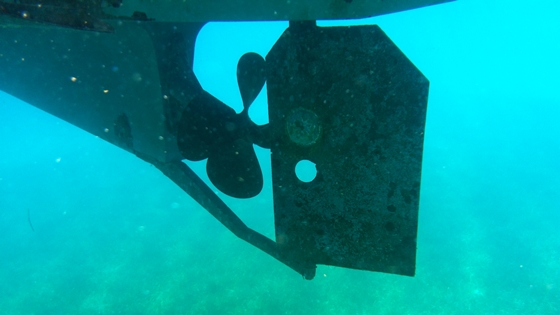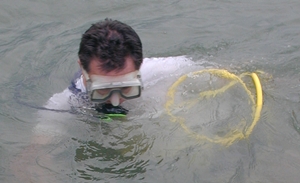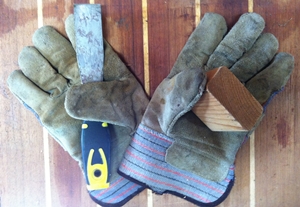10 Tips for Cleaning Your Boat Bottom and Saving Fuel
A clean bottom and running gear will improve performance and save money on fuel. Here are 10 tips that can help.
No matter what kind of boat you run – power or sail, high speed or slow – with fuel costing what it does and optimum performance always a good thing, it literally pays to keep your bottom clean. This means not only the main hull, but your foils (rudders, keels, skegs) and running gear (props, shafts, struts). In fact the hardest parts to keep clean are the most important -- propellers and rudders. Usually these are bare metal, but even if painted they are susceptible to fouling. Any significant hard growth -- meaning more than a very few barnacles -- on a propeller will have a big, bad effect on a boat’s performance. So those barnacles get top priority.

It's most important to keep rudders and running gear free of fouling. Any significant barnacle growth on a prop will seriously hurt a boat's performance.
Burnish and shine all underwater metal as much as possible at the beginning of the season – the shinier and slicker it is when it goes into the water, the longer it will ward off growth. Here are some tips that will help keep a bottom clean and a boat faster and more fuel-efficient:
1. Don't scrub ablative paint underwater. Modern bottom paints, either hard or ablative, already do a good job of keeping fouling away. Usually a fast run or a light sweep with a hand or soft sponge will help the paint shed any surface coating -- but don't wait too long between cleaning runs (see point No. 2). Ablative paints should not be abraded or scrubbed underwater, period. Scrubbing releases a high concentration of toxic material, and in fact there are plenty of local laws that prohibit underwater bottom paint cleaning, especially in enclosed waters. If you have any serious fouling where your ablative paint should be, it's time to haul the boat and repaint.
2. Prevention is a lot easier than cure. Once you’ve got barnacles, it’s very hard to get an ultra-smooth surface again – even when you scrape off the exoskeletons, much of the tenacious adhesive will remain. So don’t wait too long after launch to begin your prevention. Spend some time under the boat with a mask every couple of weeks. Again, you should be able to use your hand or a sponge to do most of the work, although a light-duty 3M pad will do a better job on dark stains above the waterline and on the boot top.

If you're not comfortable underwater, hire a diver like the one shown here with a DC-powered hookah rig, to keep fouling at bay. It will be cheaper than paying for a lot of extra fuel.
3. If you’re not comfortable underwater, hire a diver to do the work. If the bottom is free of hard fouling to begin with, it won’t take the diver much time or effort to sponge off the slime. If he has to burn through two tanks scraping barnacles off the waterline or running gear with a putty knife, it will be expensive. But it will probably still cost less in the long run than the extra fuel necessary to drag all those barnacles through the water, whether on the hull or on the blades of a struggling propeller.
4. Wear work gloves. They protect your hands from barnacles and barked knuckles.
5. For hard growth use a thick-bladed putty knife, but be careful not to gouge or score other metals. The edges of a piece of two-by-four also work well for getting the worst of the fouling off, and unlike the putty knife, the two-by-four floats.
6. Be safe. Don’t go under the boat if conditions are choppy, or if there are nearby boats throwing wakes. Getting hit in the head by a plunging boat will ruin your day.
7. Use the conditions to your advantage. If there’s a current running, start upstream and work your way down. If you can position the boat so that you can stand on the bottom while you clean, it will save a lot of energy. If possible, also turn the boat to take advantage of the sun for extra visibility.

Tools of the trade for barnacle-scraping: sturdy work gloves, putty knife, and a piece of two-by-four.
8. Handholds along the topsides will save energy. There are suction-cup handles commercially available. A long bight of line tied bow-to-stern on each side will work, too. Be sure to pull the lines back aboard after your cleaning. (They have a way of winding up in the prop if you forget them.)
9. Start with the running gear– the most important items (see above).
10. Clean all around the waterline. This is where slime, weedy growth, and stains accumulate the fastest. If you can just do the waterline down to an arm’s length underwater, without even putting your head under, you will have solved a lot of the problem and made the boat look better cosmetically. Then if possible work your way down from there, under the turn of the bilge, the chines, the counter, and on to the keel or skeg.
- Doug Logan












